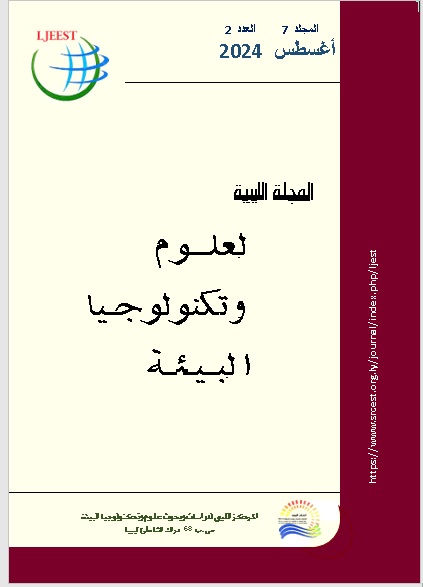تقدير التراكم الحيوي للنحاس والزنك في أشجار وترب الكافور والفيكس في مدينة درنة – ليبيا
DOI:
https://doi.org/10.63359/z8jtmq52الكلمات المفتاحية:
الزنك، النحاس، التربة، الاوراق، الكافور، الفيكسالملخص
هدفت الدراسة إلى تقدير التراكم الحيوي للمعادن الثقيلة (النحاس والزنك) في تربة وأوراق الأوكالبتوس جومفوسيفالا واللبخ نيتيدا في ثلاث مناطق مختلفة في مدينة دارنا وجدوى استغلالها في المراقبة الحيوية للهواء الملوث بالمعادن الثقيلة في المناطق الحضرية. وكانت المناطق الثلاث المختارة هي وسط المدينة ومصنع الأسمنت ومحطة البخار . تم استخدام التصميم العشوائي الكامل في التجربة بثلاثة عوامل . وأظهرت النتائج اختلافات كبيرة بين مناطق الدراسة في محتواها من النحاس والزنك حيث سجلت منطقة وسط المدينة أعلى محتوى من الزنك ، تليها منطقة محطة البخار التي سجلت أيضا أعلى محتوى من النحاس تليها منطقة مصنع الأسمنت . أظهرت الأشجار اختلافات كبيرة بينهما في محتواها من الزنك ، وسجلت الأوكالبتوس جومفوسيفالا محتوى الزنك أعلى بكثير من اللبخ نيتيدا بينما كان محتواها من النحاس ضئيلا . كما كشفت النتائج عن اختلافات كبيرة بين العينات (الأوراق والتربة) حيث كان محتوى الزنك والنحاس أعلى بكثير في التربة مقارنة بالأوراق. كان تأثير التفاعل بين المناطق والأشجار على محتوى النحاس ضئيلا بينما كان له تأثير كبير على محتوى الزنك, كان تأثير التفاعل بين الأشجار والعينات على محتوى الزنك ضئيلا بينما كان كبيرا على محتوى النحاس .كما أظهرت النتائج تأثيرا كبيرا للتفاعل بين المناطق ونوع العينة (الأوراق والتربة) وتأثير تفاعل كبير للعوامل الثلاثة على محتوى النحاس والزنك.
المراجع
Adrees, M., S. Ali, M. Rizwan & M. Ibrahim (2015). The effect of excess copper on growth and physiology of important food crops: a review. Environ. Sci. Pollut. Res., 22: 8148–8162. https://doi.org/10.1007/s11356-015-4496-5
Anant, J. K., S. R. Inchulkar & S. Bhagat (2018). An overview of copper toxicity relevance to public health. Eur. J. Pharm. Med. Res., 5(11): 232-237 http://www.ejpmr.com
Arbaoui, S., B. Campanella, S. Rezgui, R. Paul & T. Bettaieb (2014). Bioaccumulation and photosynthetic activity response of kenaf (Hibicus cannabinus L.) to cadmium and zinc.Greener.J.Agric.Sci.,4:91–100 http://dx.doi.org/10.15580/GJAS.2014.3.1216131031
Asaad, Muhammad, Ghayath Abbas, Ibrahim Nisafi and Osama Radwan. (2014). Determining the trace of some mineral elements in the dusty swimming pool on the leaves of some trees on the Syrian coast. Tishreen University Journal for Research and Scientific Studies - Basic Sciences Series Vol. (36) No. (5).
Aslam, J.; Khan, A.S.; Hkan, H.S.( 2013) Heavy metals contamination in roadside soil near different traffic signals in Dubai, United Arab Emirates. J. Saudi Chem. Soc. 17, 315–319. https://doi.org/10.1016/j.jscs.2011.04.015
Azeez, J.O., S.A. Mesele, B.O. Sarumi, J.A. Ogundele, A.O. Uponi & A.O. Hassan (2014). Soil metal pollution as a function of traffic density and distance from road in emerging cities: a case study of Abeokuta, southwestern Nigeria. Arc Agron. Soil Sci., 60:275–295 https://doi.org/10.1080/03650340.2013.792406
Baker, A. J. M. & R. R. Brooks (1989). Terrestrial higher plants which hyperaccumulate metallic elements: A review of their distribution, ecology and phytochemistry. Biorecovery1:81https://www.researchgate.net/publication/247713966_Terrestrial_Higher_Plants_Which_Hyperaccumulate_Metallic_Elements_A_Review_of_Their_Distribution_E
Cakmak, I. (2000). Possible roles of Zinc in protecting plant cells from damage by reactive oxygen species. New Phytol., 146:185–205 https://doi.org/10.1046/j.1469-8137.2000.00630.x
Castaldi S., F. A. Rutigliano & A. Virzo De Santo (2004). Suitability of soil microbial parameters as indicators of heavy metal pollution. Water, Air and Soil Pollution, 158: 21–35 https://ui.adsabs.harvard.edu/link_gateway/2004WASP..158...21S/doi:10.1023/B:WATE.0000044824.88079.d9
Chandra, R. & V. Kumar (2018). Phytoremediation: a green sustainable technology for industrial waste management. In: Chandra, R., Dubey, N., Kumar, V. (Eds.), Phytoremediation of Environmental Pollutants. CRC Press, Boca Raton, FL https://doi.org/10.4324/9781315161549 .
El-Etre, A. & Z. El-Tantawy (2006). Inhibition of metallic corrosion using Ficus extract.PortugaliaeElectrochimicaActa24(3):347–356. http://dx.doi.org/10.4152/pea.200603347
El-Khatib, A. A., N. A. Youssef, N. A. Barakat & N. A. Samir (2020). Responses of Eucalyptus globulus and Ficus nitida to different potential of heavy metal air pollution. Int.J.Phytoremed.,22(10):986-999. https://doi.org/10.1080/15226514.2020.1719031
Ernst, W. H. O., J. A. C. Verkleji & H. Schat (1992). Metal tolerance in plants. Acta Bot. Neerl.,41:229-248.https://scispace.com/pdf/metal-tolerance-in-plants-256tfcq6ts.pdf
Fontes, R.L.S. & F.R. Cox (1998). Zinc toxicity in soybean grown at high iron concentration in nutrient solution.J.PlantNutri.,21:1723-1730. https://doi.org/10.1080/01904169809365517
Foy, C., R. Chaney & M. White (2003). The physiology of metal toxicity in plants. Ann. Rev.Plant.Physiol29:511–566 http://dx.doi.org/10.1146/annurev.pp.29.060178.002455
Ghrefat, H. & N. Yusuf (2006). “Assessing Mn, Fe, Cu, Zn and Cd Pollution in Bottom Sediments of Wadi Al-Arab Dam, Jordan”. Chemosphere, 65(11): 2114-2121. https://doi.org/10.1016/j.chemosphere.2006.06.043
Gratão, P. L., A. Polle , P. J. Lea & R. A. Azevedo (2005). Making the life of heavy metal-stressed plants a little easier. Funct Plant Biol., 32(6): 481-494. http://dx.doi.org/10.1071/FP05016
Hu, Y., D. Wang, L. Wei, X. Zhang & B. Song (2014). Bioaccumulation of heavy metals in plant leaves from Yan × an city of the Loess Plateau, China. Ecotoxicology and Environmental Safety, 110: 82-88. https://doi.org/10.1016/j.ecoenv.2014.08.021
Jadia, C. D. & M. H. Fulekar (2009). Phytoremediation of heavy metals: Recent techniques.Afri.J.Biotech.,8(6):921-928. https://www.ajol.info/index.php/ajb/article/view/59987
Jaishankar, M., T. Tseten, N. Anbalagan, B. B. Mathew & K. N. Beeregowda (2014). Toxicity, mechanism and health effects of some heavy metals. Interdisciplinary Toxicol., 7(2): 60–72. https://doi.org/10.2478/intox-2014-0009
Jarup,L(2003). Hazards of heavy metal contamination
Brit. Med. Bull., 68 (2003), pp. 167-182 https://doi.org/10.1093/bmb/ldg032
Kabata, A. Pendias (2001). Trace Elements in Soils and Plants. CRC, Washington. https://www.scirp.org/reference/referencespapers?referenceid=1544363
Kabata, A. Pendias (2010). “Trace Metals in Soils and Plants” 2nd Edition, CRC Press, Boca Raton https://doi.org/10.1201/b10158 .
Kelepertzis, E. (2014). Accumulation of heavy metals in agricultural soils of Mediterranean: Insights from Argolida basin, Peloponnese, Greece. Geoderma 221–222: 82–90. https://doi.org/10.1016/j.geoderma.2014.01.007
Keller, C., M. Rizwan, J.C. Davidian, O. S. Pokrovsky, N. Bovet, P. Chaurand & J.D. Meunier (2015). Effect of silicon on wheat seedlings (Triticum turgidum L.) grown in hydroponics and exposed to 0 to 30 μM Cu. Planta, 241: 847–860 https://doi.org/10.1007/s00425-014-2220-1
Kumar, A. & N.C. Aery (2016). Impact, metabolism, and toxicity of heavy metals in plants. In Plant Responses to Xenobiotics (pp. 141-176). Springer, Singapore http://dx.doi.org/10.1007/978-981-10-2860-1_7
Lattemann, S., & Höpner, T. (2008). Environmental impact and impact assessment of seawater desalination.Desalination,220(1-3),1-15. https://doi.org/10.1016/j.desal.2007.03.009
Lewis, S., M.E. Donkin & M.H. Depledge (2001). Hsp70 expression in Enteromorpha intestinalis (Chlorophyta) exposed to environmental stressors. Aquatic Toxicology, 51: 277-2914. https://doi.org/10.1016/s0166-445x(00)00119-3
Lin, Q., Y.X. Chen, H.M. Chen, Y.L. Yu, Y.M. Luo & M.H. Wong (2003). Chemical behavior of Cd in rice rhizosphere. Chemosphere 50, 755–761. https://doi.org/10.1016/S0045-6535(02)00216-3
Liu, X., Y. Gao, S. Khan, G. Duan, A. Chen, L. Ling, L. Zhao, Z. Liu& X. Wu (2008). Accumulation of Pb, Cu, and Zn in native plants growing on contaminated sites and their potential accumulation capacity in Heqing, Yunnan. J. Environ. Sci.,20 (12): 1469–1474 https://doi.org/10.1016/S1001-0742(08)62551-6
Lombi, E., F. J. Zhao, S. P. McGrath, S. D. Young & G. A. Sacchi (2001). Physiological evidence for a high-affinity cadmium transporter highly expressed in Thlaspi caerulescens ecotype. New Phytol. 149, 53–60. https://doi.org/10.1046/j.1469-8137.2001.00003.x
Macnair, M.R. (2003) Within- and between-population genetic variation for Zn accumulation in Arabidopsis halleri.NewPhytol.155:59–66. https://doi.org/10.1046/j.1469-8137.2002.00445.x
Mahmood, T. & K.R. Islam (2006) Response of rice seedlings to copper toxicity and acidity. J. Plant Nutr., 29: 943–957 https://doi.org/10.1080/01904160600651704
Memon, A.R. (2016). Metal Hyperaccumulators: Mechanisms of Hyperaccumulation and Metal Tolerance. In Phytoremediation, 1st ed.; Ansari, A.A., Gill, S.S., Gill, R., Lanza, G.R., Newman, L., Eds.; Springer: Cham, Switzerland, e 3: 239–268. http://dx.doi.org/10.1007/978-3-319-40148-5_8
Nagajyoti, P.C., K.D. Lee & T.V.M. Sreekanth (2010). Heavy metals, occurrence and toxicity for plants: A review. Environ. Chem. Lett., 8: 199-216. http://dx.doi.org/10.1007/s10311-010-0297-8
Nasser, H., K. Khalil & S. Mahmoud (2022). Study of the cumulative ability of Ficus nitida trees for some heavy metal elements in the city of Jableh (Syria). Tishreen University Journal for Research and Scientific Studies – Biol. Sci., (44): 2. https://journal.tishreen.edu.sy/index.php/bioscnc/article/view/12788
Nolan, K. (2003). Copper Toxicity Syndrome. J. Orthomol. Psychiatry 12(4): 270 – 282. https://isom.ca/wpcontent/uploads/2020/01/JOM_1983_12_4_04_Copper_Toxicity_Syndrome.pdf
Osman, M.E.H., S.S. El-Feky, M.I. Elshahawy & E.M. Shaker (2017). Efficiency of flax (Linum usitatissimum L.) as a phytoremediator plant for the contaminated soils with heavy metals.IJAER 3:3577–3600. https://www.researchgate.net/publication/319852471_International_Journal_of_Agriculture_and_Environmental_Research_EFFICIENCY_OF_FLAX_Linum_usitatissimum_L_AS_A_PHYTOREMEDIATOR_PLANT_FOR_THE_CONTAMINATED_SOILS_WITH_HEAVY_METALS
Padmavathiamma, P.K. & L.Y. Li (2007). Phytoremediation technology: hyperaccumulation metals in plants. Water, Air Soil Pollution, 184: 105-126. http://dx.doi.org/10.1007/s11270-007-9401-5
Page, A. L., R. H. Miller & D. R. Keeny (1982). Methods of soil analysis part 2 Amer. Soc. Agric. Inc. Madison W19:595. https://www.wiley.com/en-gb/Methods+of+Soil+Analysis%2C+Part+2%3A+Chemical+and+Microbiological+Properties%2C+2nd+Edition-p-9780891189770
Rowell, D.L. (1997). Bodenkunde Untersuchungsmethoden und ihre Anwendungen. Springer-Verlag. Springer-Verlag, Berlin Heidelberg. Germany, 607p. https://www.abebooks.co.uk/9783540618256/Bodenkunde-Untersuchungsmethoden-Anwendungen-Rowell-David-3540618252/plp
Sahli, L., & Belhiouani, H. (2021). Ficus retusa L. as possible indicator of air metallic pollution in urban environmentSahli Leila, Belhiouani Hadjer. http://dx.doi.org/10.21203/rs.3.rs-282061/v1
Salt, D.E., R.D. Smith & I. Raskin (1998). Phytoremediation. Annu. Rev. Plant Biol., 49: 643–668. https://doi.org/10.1146/annurev.arplant.49.1.643
Sarhan, Y., W. Badawy, M. Frontasyeva, W. Arafa, A. Hussein & H. El-Samman (2019). Neutron activation analysis to probe the air pollution using plant biomonitoring in Egypt RAP. Conf.Proceed.,4:125–130. http://dx.doi.org/10.37392/RapProc.2019.25
Sarwar, N., M. Imran, M.R. Shaheen, W. Ishaque, M.A. Kamran, A. Matloob, A. Rehim & S. Hussain (2017). Phytoremediation strategies for soils contaminated with heavy metals: Modifications and future perspectives. Chemosphere, 171: 710-721. https://doi.org/10.1016/j.chemosphere.2016.12.116
SAS institute (2008). The SAS System for Windows, release 9.2. Cary NC: SAS institute
Schuhmacher, M., M. Nadal & J.L. Domingo (2009). Environmental monitoring of PCDD/F and metals in the vicinity of a cement plant after using sewage sludge as a secondary fuel.Chemosphere,74:1502-5108. https://doi.org/10.1016/j.chemosphere.2008.11.055
Serbula, S.M., D.D. Miljkovic, R.M. Kovacevic & A.A. Ilic (2012). Assessment of airborne heavy metal pollution using plant parts and topsoil. Ecotoxicology and Environ. Safety, 76: 209-214. https://doi.org/10.1016/j.ecoenv.2011.10.009 A.L.O. Silva, P.R.G. Barrocas, S.C. Jacob, J.C. Moreira
Silva ,A.L.O., P.R.G. Barrocas, S.C. Jacob, J.C. Moreira.(2005). Brazil. J. Plant Physiol., 17 (2005), pp. 79-93
Su, C. (2014). A review on heavy metal contamination in the soil worldwide: Situation, impact and remediation techniques. Environmental Skeptics and Critics, 3(2), 24. http://www.iaees.org/publications/journals/environsc/articles/2014-3%282%29/a-review-on-heavy-metal-contamination-in-the-soil-worldwide.pdf
Thambavani, D. S. & R. S. Kumar (2011). Effect of cement dust on photosynthetic pigments of selected plant species. Asian J. Environ. Sci., 6(2): 161–167. https://researchjournal.co.in/online/AJES/AJES%206(2)/6_A-161-167.pdf
Tóth, G., T. Hermann, M.R. Da Silva & L. Montanarell (2016). Heavy metals in agricultural soils of the European Union with implications for food safety. Environ. Int., 88:299–309 https://doi.org/10.1016/j.envint.2015.12.017
Tularam, G. A., & Ilahee, M. (2007). Environmental concerns of desalinating seawater using reverse osmosis. Journal of Environmental monitoring, 9(8), 805-813. https://doi.org/10.1039/b708455m
Yargholi, B., A. A. Azimi, A. Baghvand, A. M. Liaghat and G. A. Fardi (2008). Investigation of cadmium absorption and accumulation in different parts of some vegetables. Amer.-Eur. J. Agric. Environ. Sci., 3: 357-364. http://www.idosi.org/aejaes/jaes3(3)/10.pdf
Zhuang, P., Z. Huiling & S. Wensheng (2009). Biotransfer of heavy metals along a soil-plant-insect-chicken food chain: Field study. J. Environ. Sci., 21: 849–853. https://doi.org/10.1016/S1001-0742(08)62351-7
Zunni, S.A. & A.M. Bayoumi (2006). Important local and exotic trees and shrubs in Jabal el-Akhdar, Libya (In Arabic). Aldar Academy for printing, authoring, translation and publishing. Tripoli, Libya.
التنزيلات
منشور
إصدار
القسم
الرخصة
الحقوق الفكرية (c) 2025 المجلة الليبية لعلوم وتكنولوجيا البيئة (م ل ع ت ب)

هذا العمل مرخص بموجب Creative Commons Attribution-NonCommercial 4.0 International License.











